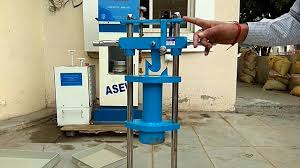Determination of impact value
SCOPE : The aggregate impact value provides the property of a relative resistance of the aggregate to sudden shock or impact.
The particular purpose which an aggregate is meant to serve requires the aggregate to have a particular strength which is usually stated in the specification.
APPARATUS : As per IS: 2386 (Part IV) – 1963 apparatus consists of:
i) A aggregate testing machine weighing approximately 45 to 60 kg weight and with a metal base with a lower surface of not less than 30 cm in diameter. It is installed on level plane concrete floor of minimum 45 cm thickness from bottom of the floor.
(ii) A cylindrical steel cup having internal dia 102 mm, depth 50 mm and minimum thickness 6.3 mm.
(iii) A metal hammer having weight between 13.5 to 14.0 kg and its the lower end being cylindrical in shape with 50 mm long, 100.0 mm in diameter, with a 2 mm chamfered at the lower edge and case hardened. The hammer should slide freely between vertical guides and concentric with the cup. Free fall of hammer should be within range of 380±5 mm.
(iv) A cylindrical metal having internal diameter 75 mm and depth 50 mm for measuring aggregates.
(v) A Tamping rod 10 mm diameter and 230 mm long, rounded at one end.
(vi) A balance of capacity not less than 500 gram, with accuracy upto 0.1 g.
PROCEDURE:
1.The test sample should have aggregates sized 10.0 mm & 12.5 mm. Aggregates may be dried at 100-110° C temperature for a period of 4 hours and then cooled at room temperature.
2.Bring the impact testing machine to rest without wedging or packing up on the level plate, block or floor, so that it is rigid and the hammer guide columns are vertical.
3. Fix the cup firmly into position on the base of the machine and transfer whole of the test sample into it and compact it by giving 25 gentle strokes with the tamping rod.
4.Raise the hammer of the machine until its lower face is 380 mm above the surface of aggregate sample in the cup and allow it to fall freely on the aggregate sample and then give 15 such blows at an interval of not less than one second between successive falls.
5.Remove the crushed aggregate from the cup and sieve it through the 2.36 mm IS sieves until no further significant amount aggregate passes in one minute. Weigh the fraction passing the sieve to the accuracy of 1 gm. also, weigh the fraction retained in the 2.36 mm sieve.
6.Calculate the aggregate impact value. The mean of two observations, rounded to nearest whole number is reported as the Aggregate Impact Value of concerned sample.For detailed practical explanation please see the below video.
OBSERVATIONS:
| Particular | Sample 1 | Sample 2 |
| Total weight of the dry sample ( W1) in gm | ||
| Weight of portion passing 2.36 mm IS sieve( W2) in gm | ||
| Aggregate Impact Value in % = W2 / W1 X 100 |
MEAN =
RESULT =
AGGREGATE IMPACT VALUE =

